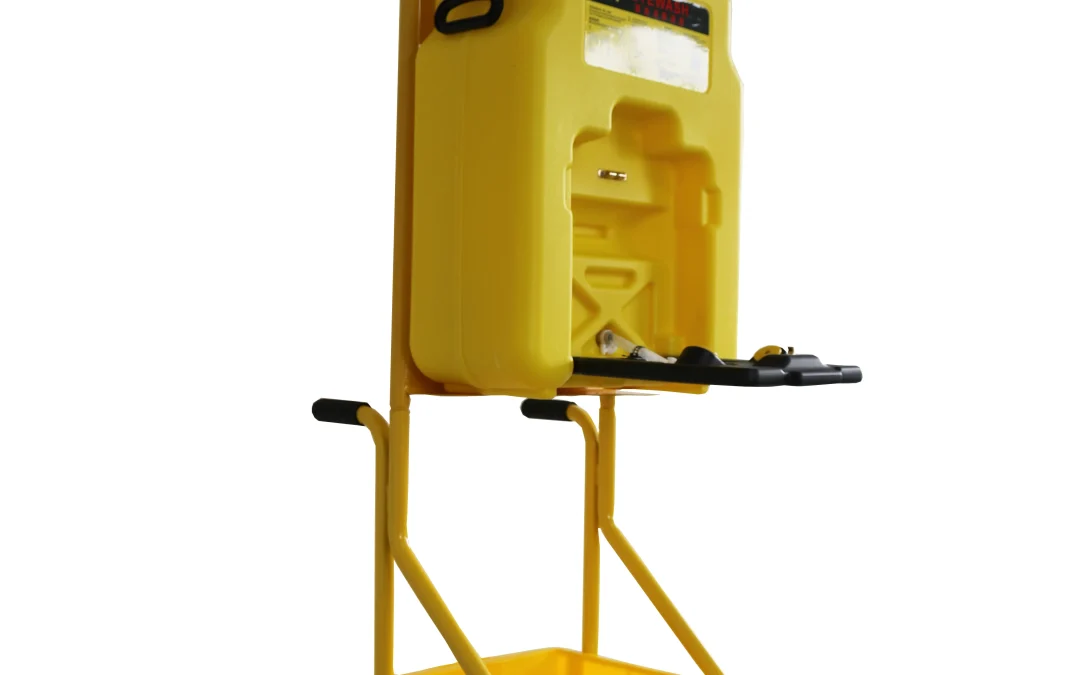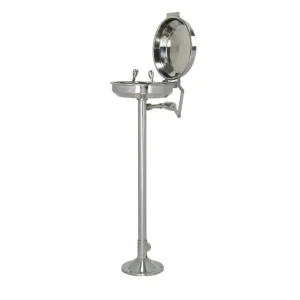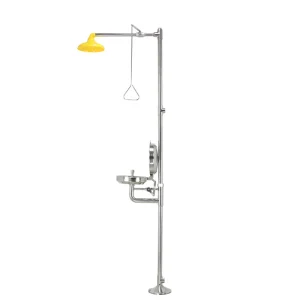An emergency eyewash station is a critical safety device designed to provide immediate flushing of the eyes and face in the event of exposure to hazardous chemicals, biological agents, or other toxic substances. Below are detailed guidelines on its components, installation, usage, and maintenance:
I. Key Components
- Eyewash Nozzles:
- Deliver a gentle, steady flow of water to rinse eyes and face.
- Equipped with dust caps to prevent contamination.
- Water Supply System:
- Connects to a potable water source (non-recycled or industrial water).
- Some models include temperature control (16°C–38°C) to avoid thermal shock.
- Activation Mechanism:
- Hand-operated: Push lever/handle to start flow.
- Foot-operated: Step on pedal for hands-free use (ideal for holding eyelids open).
- Drainage System:
- Designed to prevent water accumulation and contamination.
II. Installation Requirements
- Location:
- Within 10 seconds’ reach (15 meters) of hazardous areas (e.g., labs, chemical storage zones).
- Mounted at a height of 838–1143 mm for eyewash nozzles and 2080–2440 mm for overhead showers (if combined).
- Clear signage and unobstructed access (no obstacles within 1.5 meters).
- Water Quality:
- Use potable water or medically approved solutions (e.g., saline).
- Avoid recycled or industrial water to prevent bacterial growth.
- Environmental Considerations:
- In cold climates, install anti-freeze devices to prevent pipe freezing.
III. Usage Guidelines
- Immediate Action:
- For eye exposure:
- Remove dust caps and activate flow.
- Hold eyelids open with fingers and position eyes under nozzles.
- Roll eyes slowly (up/down/side-to-side) to ensure full coverage.
- Flush for ≥15 minutes (30 minutes for strong acids/alkalis).
- For body exposure:
- Use an emergency shower (if available) to rinse the entire body for ≥15 minutes.
- For eye exposure:
- Post-Flushing Steps:
- Seek medical attention immediately, even if symptoms subside.
- Report the incident to supervisors for documentation and risk assessment.
IV. Maintenance Protocols
- Weekly Checks:
- Test water flow and inspect for leaks or debris.
- Verify dust caps are clean and intact.
- Monthly Tasks:
- Clean nozzle filters to prevent clogging.
- Flush blind pipes (stagnant sections) to replace old water.
- Annual Servicing:
- Have a professional inspect the station and replace worn parts.
- Record-Keeping:
- Document all tests, maintenance, and incidents for compliance audits.
V. Critical Safety Notes
- Prohibited Actions:
- Never use for non-emergency purposes (e.g., washing faces).
- Do not share with others to avoid cross-contamination.
- Special Scenarios:
- Strong acids (e.g., sulfuric acid): Wipe away visible chemicals with a dry cloth before flushing to prevent heat generation.
- Solid particles in the eye: Blink rapidly to dislodge debris; seek professional help if particles remain.
- Training Requirements:
- All personnel handling hazardous materials must undergo annual training on eyewash station usage.
- Conduct emergency drills every 6 months to ensure readiness.
VI. Regulatory Standards
- ANSI Z358.1-2014: Requires eyewash stations to deliver ≥1.5 L/minute of water for ≥15 minutes.
- OSHA 29 CFR 1910.151: Mandates their availability in workplaces with corrosive materials.
- ISO 9001/CE Certification: Ensures compliance with quality and safety benchmarks.
VII. Common Misconceptions
- Eyewash vs. Eye Wash Bottles: Bottles are for minor irritants; stations are for large-scale exposure.
- Electrically Heated Stations: These only maintain water temperature when not in use; flow temperature depends on the supply line.
By adhering to these guidelines, you can ensure the proper functioning of emergency eyewash stations and minimize injury risks in hazardous environments.






